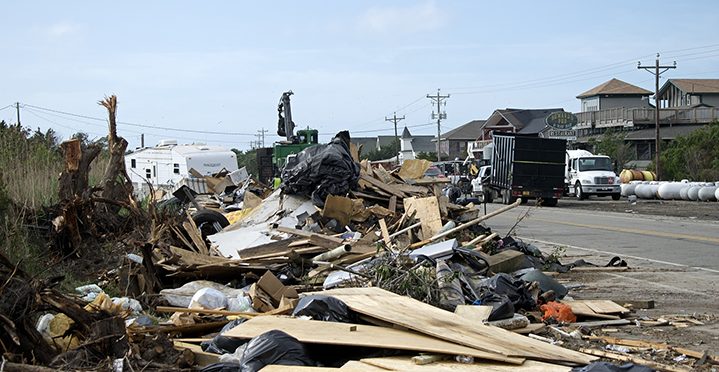
RALEIGH – Disaster aid legislation is stalled in the North Carolina General Assembly as House and Senate negotiators work through differences in competing versions of the bill.
Among the top difference is the House’s inclusion of resiliency funding and a handful of significant policy shifts, initiatives Senate leaders say should wait until next year.
Supporter Spotlight
The Senate’s bill is aimed mainly at replenishing state matching funds for federal recovery programs.
Spending in the two bills differs considerably, with the House plan at $280,518,719 and the Senate’s at $130,812,336.
Also up in the air is how much the state will put into disaster aid for Ocracoke Island and mainland communities now that the state has been denied federal aid for individual assistance, a key source of housing repair and rehabilitation funds. Federal officials turned down the state’s request last month, saying it did not meet damage thresholds.
The state did receive approval for federal public assistance that will help cover debris removal and infrastructure repair costs.
The House bill includes flexibility to use some of the state disaster funds to help repair homes and businesses damaged during Hurricane Dorian in September, as well as $1.7 million for Ocracoke school repairs and elevation and $1.8 million for a pump station and flood-control infrastructure at Lake Mattamuskeet, items not included in the Senate legislation.
Supporter Spotlight
Both the House and Senate versions include a $30 million appropriation to the North Carolina Department of Transportation.
In explaining the House bill to the chamber’s Appropriations Committee, co-sponsor Rep. Chuck McGrady, R-Henderson, said the bill represents a shift in approach, moving the state from a storm-by-storm response to one that recognizes that major storms are bound to occur with far more frequency.

“This bill is in some ways a pivot from what we’ve done in the past because for the first time you’re seeing a large portion of the bill deals with resiliency or mitigation,” McGrady said. “When Hurricane Matthew hit us, we put in disaster relief to deal with the specific things that occurred. Then Florence hit us, then Michael hit us.”
The bill would add positions at the Office of Recovery and Resiliency, which was created earlier this year, to facilitate the flow of federal assistance and would accelerate resiliency planning throughout the state, including a targeted program through the Department of Environmental Quality’s Division of Coastal Management for the state’s 20 coastal counties.
McGrady said the bill also makes it easier for state agencies and local governments to shift unspent funds from one storm to needs related to another.
As the House moved its plan, the Senate took a different approach, advancing a bill that included the needed matching funds and little else.

Sen. Brent Jackson, R-Sampson, said he and his colleagues wanted more time to work through parts of the bill that go beyond immediate needs for matching grants. Jackson said he preferred to wait until the legislature returns in mid-January to take up other portions of the bill.
“We wanted to stick with just the federal match,” he said in an interview last week. “I think we’ll revisit it all at that point in time and we’ll have a better handle on what actually went on with Dorian that we don’t have now, as far as the damage.”
Both chambers appointed conferees to work out a final version of the bill.
House appointees are McGrady, the House chair, Reps. John Bell, R-Wayne, Donny Lambeth, R- Forsyth, Billy Richardson, D-Cumberland, and Jimmy Dixon, R-Duplin. Senate appointees are Jackson, the Senate chair, Sens. Harry Brown, R-Onslow, Kathy Harrington, R- Gaston, Danny Britt, R-Columbus, and Ralph Hise, R-Madison.
In an interview with Coastal Review Online, Rep. Bobby Hanig, R-Currituck, said he was disappointed a deal couldn’t be struck on the additional aid, especially Hyde County’s needs for Ocracoke and the mainland.
Hanig said that until the final version of the legislation is worked out, it’s difficult to assess what it will mean for the heavily damaged areas in his district. He’s willing to wait to discuss the resiliency portions of the bill, but not state aid to the hurricane victims.

“I’m focused on the immediate recovery needs,” he said. “Resilience is something we have to look for down the road, but we have immediate needs that need to be met. We can’t make people wait for that.”
Ocracoke faces a long recovery regardless, he said, given the difficulties of getting needed materials to the island and getting debris off it.
“The logistics are the most severe you could imagine to get things done there,” Hanig said. “You have construction workers on a ferry five hours a day just going to or from work because there’s no place for them to stay.”
The next steps for the bill are unclear, but the deadlines for sections of it are not. State matching funds are estimated to start running out before the end of the month and the legislators would need to pass at least that portion of the bill when they return to Raleigh on Nov. 13 to avoid a disruption of federal funds.
Any funding beyond that will be up to the conference committee.
Bell, the House majority leader, expressed confidence last week that some of the House priorities would make it into the final version of the bill.
Bell was part of a House negotiating team that insisted that conference reports, including the disaster legislation, be eligible for consideration when the legislature returns.
Whether the final product includes both the additional Dorian assistance and the resiliency efforts is still a question, however.
During a hearing last week, Bell told his colleagues that putting the funds into resilience was a step in the right direction in improving the state’s follow-through on storm response.

“We do a really good job before the storm, during the storm and immediately after the storm,” Bell said. “We have been, as has been mentioned, lacking on the long-term recovery side.”
Bell, who led a recent select House committee that looked into hitches in disaster aid, said he’s convinced the state is now moving in the right direction on long-term recovery and resiliency. The need for it is clear he told colleagues.
“Hopefully we’ll get a couple years of relief and no storms,” he said. “But we’ll probably get another storm and we need to be prepared.”
Bridget Munger, a spokesperson for the Office of Recovery and Resiliency, said the new office and the Department of Emergency Management are committed to getting help for hurricane survivors.
“Due to the impacts of four storms over the past three years, many communities have substantial unmet needs that must be addressed. We will continue our efforts to work with the legislature to meet those needs as quickly as possible,” she said.
Crunching the numbers
Here’s a breakdown of the two bills:
Senate Version of House Bill 200, The 2019 Storm Recovery Act
Totals $130,812,336 in spending, appropriates the following:
- $70,812,336 to the Hurricane Florence Disaster Recovery Fund to provide state match for Florence-related federal disaster assistance programs.
- $11,197,013 for state match for Hurricane Matthew-related federal disaster assistance programs.
- $4,176,245 for state match for Hurricane Matthew-related federal disaster assistance programs.
- $16,300,000 for state match for Hurricane Dorian-related federal disaster assistance programs.
- $30 million to the Department of Transportation for current and future Hurricane Dorian activities such as debris removal, highway and infrastructure repair.
Policy Provisions include the following:
- State universities and other nonstate entities that receive funds are required to seek private donations to help cover losses.
- No state funds are allowed for construction of new residences within the 100-year floodplain.
- $30 million nondisaster-related appropriation to the state Rural Health Care Stabilization Contingent Fund.
House Version — H1023, Storm Recovery Act of 2019
Totals $280,518,719 in spending, appropriates the following:
- $70,812,336 to the Hurricane Florence Disaster Recovery Fund to provide state match for Florence federal disaster assistance programs.
- $11,197,013 for state match for Hurricane Matthew-related federal disaster assistance programs.
- $4,176,245 for state match for Hurricane Matthew-related federal disaster assistance programs.
- $17,800,000 for state match for Hurricane Dorian-related federal disaster assistance programs and similar state assistance that may supplement federal assistance or cover housing repairs and rehabilitation for those who do not qualify for federal assistance.
- $5 million to replenish the state’s Emergency Response and Disaster Relief Fund for future storms.
- $40 million to the state Office of Recovery and Resiliency to cover a $20 million bridge loan program for distressed local governments impacted by hurricanes Matthew, Michael, Florence or Dorian; $10 million in grants to local governments for Dorian disaster recovery; and $10 million for assistance and staff support to help local governments and regional agencies to develop resilience implementation.
- $17,600,000 to the Department of Environmental Quality for the state match for additional federal funds for the state’s Clean Water State Revolving Fund and the Drinking Water State Revolving Fund.
- $1.3 million to DEQ for four temporary positions and funding for coastal resiliency planning for all 20 coastal counties.
- $50,000 to DEQ for repair, restoration and recovery at the state’s Coastal Reserve sites damaged during Dorian.
- $30,000 to the Wildlife Resources Commission for repair and restoration to boating access areas in Carteret and Currituck counties.
- $30 million to the Department of Transportation for current and future Hurricane Dorian-related activities such as debris removal, highway and infrastructure repair.
- $2 million to DOT for living shoreline projects near key transportation infrastructure.
- $2 million to DOT to expand the state’s flood inundation mapping alert network, or FINMAN.
- $2 million to DOT for flood risk assessment along highway major transportation routes.
- $5 million to the Division of Emergency Management for expansion of flood mitigation studies
- $4.8 million to DEM for water and breach level monitoring systems for 1,510 high- and intermediate-risk dams.
- $32.3 million to DEM for LiDAR topography updates, aimed in at improving flood and landslide mapping.
- $5.2 million for repairs to storm damage at Elizabeth City State University.
- $1.7 for a direct grant to Hyde County for repairs at the Ocracoke School.
- $15 million for Golden LEAF grants for infrastructure repair.
- $1.8 million to Hyde County for a pump station and watershed restoration infrastructure for Lake Mattamuskeet.
- $753,125 for funding of the 2-1-1 program and new positions to administer federal grants for the Department of Public Safety.
- $5 million to the Department of Agriculture for the state’s swine buyout program to cover buyouts of high-priority operations in the 100-year floodplain.
- $5 million for stream debris removal.
Policy Provisions include the following:
- Adds flexibility in reporting for local governments to allow them to combine costs and projects and reallocate funds from individual storms.
- Allows local governments to use prequalified contractors during emergencies and disaster recovery.
- Implements a legislative review panel’s recommendations for new state systems, responsibilities and oversight for disaster recovery under the Office of Recovery & Resiliency.
- Appropriates $2 million for the extension of a pilot program that assists low income households in obtaining flood insurance.
- Appropriates $1 million to the Wildlife Resources Commission and authorizes the WRC to remove and dispose of abandoned and derelict vessels.








